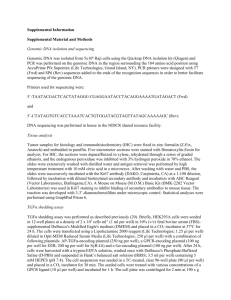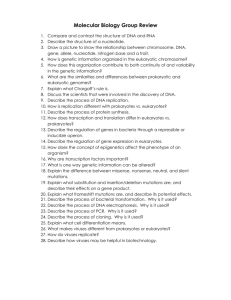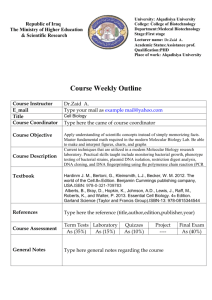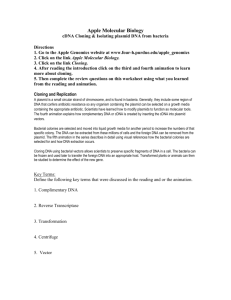Cloning the Saccharomyces RAD23 Gene in Tetrahymena
advertisement
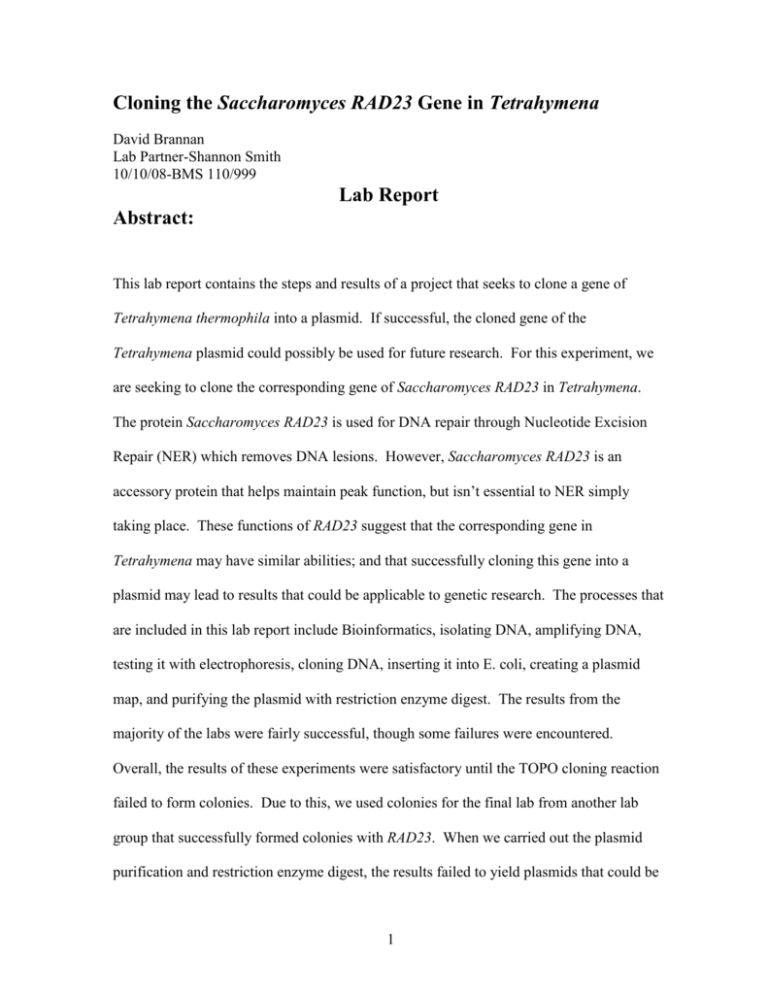
Cloning the Saccharomyces RAD23 Gene in Tetrahymena David Brannan Lab Partner-Shannon Smith 10/10/08-BMS 110/999 Lab Report Abstract: This lab report contains the steps and results of a project that seeks to clone a gene of Tetrahymena thermophila into a plasmid. If successful, the cloned gene of the Tetrahymena plasmid could possibly be used for future research. For this experiment, we are seeking to clone the corresponding gene of Saccharomyces RAD23 in Tetrahymena. The protein Saccharomyces RAD23 is used for DNA repair through Nucleotide Excision Repair (NER) which removes DNA lesions. However, Saccharomyces RAD23 is an accessory protein that helps maintain peak function, but isn’t essential to NER simply taking place. These functions of RAD23 suggest that the corresponding gene in Tetrahymena may have similar abilities; and that successfully cloning this gene into a plasmid may lead to results that could be applicable to genetic research. The processes that are included in this lab report include Bioinformatics, isolating DNA, amplifying DNA, testing it with electrophoresis, cloning DNA, inserting it into E. coli, creating a plasmid map, and purifying the plasmid with restriction enzyme digest. The results from the majority of the labs were fairly successful, though some failures were encountered. Overall, the results of these experiments were satisfactory until the TOPO cloning reaction failed to form colonies. Due to this, we used colonies for the final lab from another lab group that successfully formed colonies with RAD23. When we carried out the plasmid purification and restriction enzyme digest, the results failed to yield plasmids that could be 1 Abstract: (Continued) used for future research. Therefore, in order to achieve a product, we would have to start back at the TOPO cloning reaction and make another attempt to have it work. If that fails, the most promising place to restart would probably be to once again isolate the gDNA of Tetrahymena. Introduction: In this project, we are seeking to clone the corresponding gene of the protein Saccharomyces RAD23 in Tetrahymeana to create a plasmid that could potentially be used for research. Tetrahymena are free living ciliate protozoa that are common in fresh water, used for research, and have a variety of complex and specialized cell structures. The protein Saccharomyces RAD23 is involved in Nucleotide Excision Repair (NER);2,3 which serves as a DNA repair mechanism for possible mutations. The RAD23 gene was originally found in yeast, but has since been found to perform a variety of functions including binding to DNA during replication, initiating the targeting of proteolytic substrates, and being partially responsible for ultraviolet induced DNA repair. The importance of RAD23 can be easily seen in DNA replication. When RAD23 doesn’t function correctly or is absent in DNA replication, the phosphate base thymine binds with another thymine, as opposed to adenine (the proper binding pair). In humans, this abnormality causes Xeroderma pigmentosum, which makes human skin unable to repair itself, and therefore precludes an individual from getting UV exposure8. This information displays the importance that RAD23 plays in NER and though not completely essential to it, it fulfills a crucial role. 2 Introduction: (Continued) Given the importance of the protein Saccharomyces RAD23 in NER, successfully cloning the corresponding gene in Tetrahymena could be used to research certain genetic abnormalities. In this case, cloning refers to isolating a defined DNA sequence and obtaining multiple copies of it1. Cloning has essentially four processes: fragmentation, ligation, transfection, and screening/selection. Fragmentation is where the DNA is essentially separated into fragments and amplified, usually through Polymerase Chain Reaction. Ligation is a procedure where the amplified fragment is incubated with the enzyme DNA ligase under appropriate conditions. Transfection is the process where the DNA is transfected into cells, which can be done chemically or through electroporation. Finally, the transfected cells are cultured. Ultimately, the goal of this project is to clone a gene of Tetrahymena into a plasmid that could be used by other researchers. 3 Materials and Methods Bioinformatics The amino acid sequence of Saccharomyces RAD23 was found through the database www.ncbi.nlm.nih.gov, and the corresponding Tetrahymena homolog was found through the webpage www.cilitate.org. The top three results can be found in the results section. The IPI (Human) and SGD protein homologs for the TTHERM_# were also found and recorded. The protein sequence of the Tetrahymena homolog was found with a ORF Translation coding sequence and labeled Tt RAD23 amino acid using the webpage www.ciliate.org. The Tetrahymena homolog with the highest e-value was used to find the nucleotide sequence with the www.ciliate.org resource and labeled as Tt RAD23 CDS. The genomic sequence of Tt RAD23 was found with the highest TTHERM_# at www.ciliate.org. With the same resource, the Tt RAD23 sequence was found with NTS and underlined EST’s. Finally, the amino acid sequence of Saccharomyces RAD23 was compared with the sequence Tt Saccharomyces RAD23; a second comparison was made between the amino acid sequence of Saccharomyces RAD23 and the results of the first comparison using the website www.ncbi.nlm.nih.gov. 4 Tetrahymena Genomic DNA Isolation First, 1.4mL of Tetrahymena culture was pipeted into a microcentrifuge tube. The tube was then placed in the centrifuge for one minute at 10,000 revolutions per minute; afterwards the supernatant was removed. The pellet that was formed from the centrifuge cycle was then flicked to loosen residual supernatant, and 700µL of Urea Lysis Buffer was added to the tube to protect the pellet from a possible change in pH. Next, 600µL of phenolchloroform was added to the tube; the tube was then mixed. The tube was placed into the centrifuge for 5 minutes; the top layer was then transferred to a new tube. The process from when the phenol chloroform was added to now was repeated. 150µL of 5M NaCl was added to the removed lysate. To precipitate the DNA, 700µL of isopropyl alcohol was added to the lysate; the tube was then inverted 10 times, stood for 10 minutes, and was centrifuged for 10 minutes. After centrifuging the supernatant was removed and 500µL of 70% ethanol was added. The tube was then centrifuged for 3 minutes, supernatant was removed, and the pellet was air dried. 50µL of Tris-EDTA was then added to the tube and mixed; 1µL of RNase A was added and the tube was incubated at 37 °C for 10 minutes. Finally, the tube was labeled accordingly. 5 Polymerase Chain Reaction First, the primers that were designed for my reaction were distributed by the instructor and were resuspended with the appropriate amounts of sterile ddH2O. The stock solution was determined to have a final concentration of 200uM; it was later diluted in a different tube to have 200µL of a 20uM, which will be called the working stock. The amount of sterile ddH2O to add to each was then calculated to be: Gene TF=136.5µL, and Gene TR-163.0µL. Figure 1. The coding sequences below represent the coding sequence for the primers that were ordered for both the RAD23-TF and RAD23-TR genes to isolate the genomic DNA of both through PCR. RAD23-TF (34-MER; TM=54°C) 5’-CAC CCT CGA GAA GAT CAA CAT TAA GAC TTT AAA G-3’ RAD23-TR (30-MER; TM=54°C) 5’-CCT AGG TCA TTA ATA CAT AAA ATC ATC GTC-3’ The water was added after briefly centrifuging the tube. The working stock solutions were then created. The PCR reactions were now set up according to the calculations made in the Pre Lab5. Four reactions were set up; that is two genomic DNA with primers for each person. Our solutions were divided as follows: 1-DB gDNA, 2-DB gDNA, 3-SS gDNA, and 4-SS gDNA. The two letters before each reaction represent the initials of me and my lab partner. The master mix was then created, and as was the working stock; the components can be found in Figure 2. 6 Polymerase Chain Reaction (Continued) Figure 2. The following table shows the amount of each ingredient that was used to make the mixes for the four genomic primers as well as the master mix. Final concentration Stock concentration Master Mix 1.0 µg (total) genomic DNA 0.43 µL 2.32_ (calculated) 0.2 μM sense primer 1.25 μL 20 μM x 3 3.75uL 0.2 μM antisense primer 1.25 μL 20 μM x 3 3.75uL 1 unit (U) Phusion polymerase 0.5 μL 2 U/μL x 3 1.5µL 1X HF or GC buffer (1.5mM MgCl2) 10_ μL 5X concentrated x 3 30 µL 0.2 mM dNTPs Sterile distilled water 1_ μL 10 mM x 3 3 µL 35.57μL x3 106.7 µL _______________________________ FINAL VOLUME: 1.29 µL _______________________________ 50 μL 150 μL The correct amount of master mix was then pipeted into each tube; to make a total volume of 50µL in each tube. When this was complete roughly 48µL of master mix remained. The four tubes of primer were then placed in a thermocycler at the closest temperatures available to those calculated in Pre-Lab 5(can also be found in results). The thermocycler will then take the primer tubes through an incubation process that will heat up and cool the primers to amplify the DNA. 7 Agarose Gel Electrophoresis Agarose gels in electrophoresis chambers were already in place for the beginning steps of this experiment. First, the comb and side walls of the gel covering were removed and 1X TAE was poured into the electrophoresis chamber until the top had only a thin layer over it. Sample dye (1 µL dots) had been previously made by the laboratory instructor. The first slot that the comb made in the gel was filled with 5µL of 1 kb ladder. Next, 10µL of each primer was mixed with the dyes and placed in the gel slots. With the primers in place, 90 volts of electricity were then added to the electrophoresis chamber for 75 minutes. The sample dyed primers that were placed into the gel slots eventually came close to the middle of the gel. The gel apparatus was then visualized to determine the quality of the primer. 8 TOPO Cloning and E. coli Transformation We began setting up the TOPO cloning reactions by adding the necessary components. The following represents the quantities that were calculated to be necessary for the TOPO cloning reaction. The amount of PCR to be used was determined by visually comparing the ladder key of base pairs (bp) with the SS-4 gDNA image that was taken in lab 7(Result 4Figure 2). It was visually determined to be 250ng, which went through the following calculation: (250) x (10) x (0.1)=250ng. The amount of PCR product was determined by 10µL 250ng=0.04µL/ng. It was determined that 10 250=0.04ng; therefore 0.04ul/ng x 10ng=0.4µL; 0.4µL of PCR product will be added to the solution. The other solutes that were added to the TOPO mix are as follows: Salt Solution: 1µL and TOPO Vector: 1µL. Since the final volume of the solution must be 6µL, the amount of sterile water to was calculated as follows: 6µL-1µL -1µL -0.4µL =3.6µL of sterile water. After calculating and combining the solutes, the solution was mixed by pipeting up and down. The tube was then allowed to sit for 10 minutes at room temperature. Next, we thawed our 5mL tubes of E. coli for 5 minutes, after doing so we added 2µL of the TOPO solution made previously to the E. coli tube and gently mixed them with a pipet tip. The E. coli tube was then incubated on ice for 10 minutes. After incubating, the E. coli tube was heat shocked for 30 seconds in a 42 °C tub of water and was immediently transferred to ice. After transfering to ice, 250µL of SOC Medium was added at room temperature. The tube was then placed in a horizontal shacking incubator for 50 minutes. Once the incubation was complete, roughly 20 sterile glass beads were added to two different plates. Now, 200µL and approximately 50µL of the TOPO mix were added to each plate. The plates were swirled with the beads to ensure that the solution was adequately spread. 9 TOPO Cloning and E. coli Transformation (Continued) The beads were then removed from the two plates and incubated overnight at 37 °C. Constructing a Plasmid Map and Restriction Enzyme Digestion Design Plasma Maps are graphical representations of plasmids that show the major sites such as genes, plasmid names, and restriction enzymes. The first step was to retrieve the RAD23 Tetrahymena Sequence and the plasmid sequence used to clone the PCR product from the online Blackboard resource. After acquiring these sequences, a gene construction program was opened to create the plasmid map. The program then opened a circular plasmid that had the RAD23 Tetrahymena sequence inserted into it. We next found the region where the gene will be inserted between the brown colored sequences where the sequence was blue and read CACC. This sequence matched part of the primer sequence made for our primers. The CACC was then highlighted and pasted into the gene sequence and the junction marker was highlighted and deleted. We next changed the gene sequence to green; and highlighted the intron sequences and copied them. The RAD23 sequence was then pasted in the gene construction program; all the introns were highlighted and changed to the color black. We then went back to the plasmid and highlighted the green and black regions. The gene 10 Constructing a Plasmid Map and Restriction Enzyme Digestion Design (Continued) construction kit was used to change the green and black regions to the ‘widest line’ setting on the plasmid map. The plasmid map was then saved as pENTR, TtRAD23. The previously saved plasmid map was used to mark the restriction enzyme sites found in the handout from Lab 7(see lab notebook for handout). A toolbar was opened and the program was set to ‘Commercial’ and each constriction enzyme was added. The program then displayed all the sites found in the plasmid that correspond to a certain palindromic sequence. The plasmid map was then evaluated and it was determined that the NHE1 restriction enzyme was the best for determining that the RAD23 gene was in the plasma. The NHE1 sequence was then highlighted and copied. The document type was then changed to Gel; the gel bands from the digest were pasted in. The size of the DNA was then changed by setting the threshold to 500 base pairs. The gel picture was saved as pENTR, TtRAD23, NHE1 digest. The gel was changed to a table and saved as pENTR, TtRAD23, NHE1 Table. All of the documents were then saved for future use and reference. 11 Plasmid Purification and Restriction Enzyme Digest The first step in this lab was to grow the bacteria that would be used later in the lab. We began by taking 6ml of LB with 50µg/ml Kanamyacin in three different glass test tubes(six total, three per person). A LB/KAN plate was labeled pENTR, TtRAD23, DBSS; a grid was drawn on the plate that contained six numbered squares. We then used sterile six inch wooden sticks to take colonies from the colonies transformation plate and mark them on the grided plate. It must be noted for this experiment that we used colonies from lab students that were also assigned the RAD23 gene. The remaining material on each wooden stick was mixed with the liquid in the LB/KAN test tube. The test tubes were then placed in the shacking incubator at 37 C overnight. Next, a total of eighteen 1.5ml tubes were labeled as 1A, 2A, 3A, 2A, 2B, 2C, etc. Culture was then pipeted into each tube with roughly 1ml left in the test tube. The tubes were centrifuged at maximum speed for three minutes. The supernatant was removed from each tube. We then added 250uL of buffer P1 to each A tube of the six sets. The pellet was then resuspended by pipeting up and down; after pipeting, the contents of each A tube were transferred to the B tube and resuspended. Finally, the contents of the B tube was transferred to the C tube and resuspended. We added 250µL of Buffer P2 to the C tube and inverted it to create a through mix. The solution then turned blue, but after gaining a through mix we turned the tube right side up and added 350uL of Buffer N3 to ensure the plasmid DNA wasn’t damaged. The tubes were then inverted until the solution turned clear and was homogeneous; and the tubes were centrifuged at maximum speed for 10 minutes. Pipets were then set to 900µL and used remove the supernatant (roughly 850µL) from the tubes and pipeted into QIA prep spin 12 Plasmid Purification and Restriction Enzyme Digest (Continued) columns. The QIA prep spin columns were then centrifuged for 1 minute and the flow through top of the spin column was removed and discarded. We next centrifuged the tubes for 1 additional minute to remove any residual buffer. The column was placed in a new 1.5ml tube with 50µL of Elution buffer. The tube stood for 2 minutes, and was centrifuged for 1 minute; the column was then discarded. The tubes were placed on ice with the labels 1Rad23DB and 2Rad23SS. We now confirm the plasmid by inserting the plasmid PCR with restriction enzyme digest. The restriction enzyme was determined to be NHE1 from the previous lab and the restriction buffer to be used is NHE1 Buffer 2. It was also determined with the handout that the reaction will require a BSA. We then created a cocktail that included the following: 14µL of Buffer2, 1.4µL of BSA, 3.5µL of NHE1 Buffer 2, and 107.1µL of sterile water. We then pipeted 18ul of the cocktail in six tubes and labeled the tubes with DBSS, NHE1, and the plasmid number (1-6). We next added 2µL from the plasmid tube to the corresponding cocktail tube; which was incubated at 37 °C overnight. Finally, we determined the quality of the primers through Agarose Gel Electrophoresis (steps can be referenced in the Agarose Gel Electrophoresis Part of Methods) to determine if the samples will have the necessary qualities to be used in the future. 13 Result 1-Bioinformatics CACCGTCGAGAAGATCAACATTAAGACTTTAAAGGGCACTGATTTTTTTGATGTTAACCTT GAAGAAACTGCTACAGTAAATTTATTAAAATGTTTTGTTTTAGGAGAGCTCGAATTCTTGT TGACATTTTAAGAATTAGCTAGATAAATACTTGTTTTCAACATATTTTATAATCTTGTTAG GTTGCTGAATTGAAGGAGAAGATTGCTACTGAAAAGTAAAAGGAAAAAGATACTATTAAGT TAGTTCATAAAGGTAAATAATTGACCGAAGACTCTAAGACTCTTGGCGAACTTGGTATTAA AGATAATGATTTTGTTATTCTCATGTTCTTTTAAAAGGTAATATTATCTTAGTTTTAAGAT TTCTTCAAAATGCGGCTATCTATTTATTTCTCTTTCTATGTGTGCTTTCTTTTAATCATGA TTAAATTAGAAAAATTCTTCAAAAAATGAAGTAAAATCAATATTTTCTTTGTCGAATTGTA CACAATTTAATGTGACATGACACTGAAATCATCTTAGTGACTGTTAAGCATTTTAATAGAT GAATAATAGATAAAGTAGCATAGAAAGCAGAGAAAATTTTATGGCTAGCATTTAATGAAAG AAAGAAAGAAAGAATGAAATTGCAATTATAATTTAAAAAATAATAAACTAAATATAACATT ATTATAGAAAGCAGAAAAAGAAGATGCTCCATAATAAGCTTAATCTGATACCACTTCTACT ACCTCCGCTGCCTCAACAACTGCTACTAACCCCACTACTGTTCCTAAGCCTGCTGTTTCCT AACCCGCTACAACATAATAAACAGGAAGTTAAGGAACAGGTAGTGATCTCCTTTAAGGTCC TGAATTGGAAGCCAAAATTAAAGAAATTGAATCAATGGGTTTTGAAAGACCTAAGGTTCTT TAAGCTTTGAAGGCCGCTTATTACAATCCTGAAAGAGCAGTTGATTATTTACTCAGTGGTA ATATTCCTAAAGAACCTAGTTAATAATAGAGTCCTTTACAAGGCTTACAAGGTCCTGGTGT TGAATAATTAGCTTAATTAGCTTAAAATCCTCAATTCCAACACATTGCTTAAGCTATTCGT TAAAACCCTGCTCTTCTCCAACCTGTCATGTAATAATTAGCTTAAACTAACCCTGATGTTG CCAGACTTTTACAATAAAACCCTCAAGCTTTCTTGCAACTCCTCCTTGCTGCCTCTGAAAA CGAAGGTGGATAAAGTAATAATTTTAAATTGTTAATTTTTCATGGACTTTAAATGCTAAAA TAATTGACAAAAGAAAGTCTTTTACTTTTCCATTAAAGACAAAAAGAATATAAATTCTTGT ATCTGTCTTTCTTTCTTTCTATCTATTTATCTTTCTATTGATTGATTTAAATAATCTGATC TGATTAAAGAAAATAGAAAAGAGCAGAATTGATTAGTTAGCATATCTTCTTCGTTTTTCTA TTTATTTTTTAATAAAAATTAATCTTTAAAATTAATTAGCCTTACCTCCAAATGCCATCCA AGTCACTCCTGAAGAAAAAGCTGATATTGATGACATTATTTCTATGGGTTTTGATAAAAAT GACGCCTTAGAAGCATATATTACCTGCGACAAGAACAAAGAATTAGCAATTAACTATCTTT TCGAAGCAAGGGAAAGCGGTACTCTTCTTTGTAAGAAATATTAACTTTTTTTTTTTTAATT CAAGAAAGCAAGCAAGTTTAAAAAAGCAATTGTGTATATAAATAAATCATTAAATTAAAAT AAGAAATAGTTGAAAAAAAAGATATTCATTCATCCATTCACATAGTAAATATTCTAAATAA ATTTTTATTTAATTAAATAGCTGAACACATCCAAAAGGAAGAATTAGAAGCTGCATAATAA TAATCATAAAACTAAAATTAATAACAATAAGGTAATAACCCAAATCAATAATAATAATAAG GTGGATAAGGTGAAGGTGGTGATAATGATGATGAAGATGACGATGATTTTATGTATTAATG ACCTAGG Figure 1: The above coding represents the genomic sequence of DNA for the gene Tt RAD23; the above figure represents Tt RAD23 Genomic= 2020 Base Pairs (bp) or cDNA= 1195 bp. The black part of the sequence represents the introns that are removed from the genomic sequence of RAD23. The red shows the sequence that is present in mature RNA, and the highlighted yellow portions represent the sequence of primers that are used to amplify the TtRAD23 gene in the PCR process. 14 Result 1-Bioinformatics Result 1.1-Bioinformatics Written Results The top three results for TTHERM_# were the following: TTHERM_00013290/2.2e-17, TTHERM_00085190/0.033, and TTHERM_00346560/0.043. The TTHERM_# used to find the genomic sequence of DNA was TTHERM_0034560. It must also be noted that the black introns in Figure 1. are regions of DNA that are not transported to proteins7. Result 2-Quantifying the Genomic DNA of Tetrahymena Result 2.1 After acquiring the genetic coding sequence for TtRAD23, we began to isolate the genomic DNA of the Tetrahymena. The following shows the results from when two sets of DNA were isolated for genomic DNA. The two dilutions of DNA were placed in a spectrophotometer and tested at both A260 and A280 wavelengths of light. The results for each solution are shown in the information below: Result 2.1 1:100 dilution 1:200 dilution A260 A280 0.006 0.008 A260 A280 0.089 0.047 Result 2.3 A discrepancy resulted in the numbers that we received during lab and those the lab instructor received for the 1:100 dilution. For the purpose of calculating DNA purity, I choose to use the instructor’s numbers, which I believe are the correct ones. Result 2.3 1:100 dilution A260 A280 0.464 0.220 15 Result 2-Quantifying Genomic DNA of Tetrahymena Result 2.4 The DNA stock concentration was determined with the numbers that the lab instructor determined. Formula for stock concentration- (50) x A260 x Dilution Factor 1000mL The dilution factor for this process is 100; because we have determined to use the 1:100 dilution, since it has a higher quality. Final Results- (50) x (0.464) x (100) 1000mL Final Stock Concentration=2.32 µL/mL Result 2.5 The DNA purity was determined with the following equation; and for this purpose any ratio above 1.7 would be considered good: A260 A280=2.1 Result-3-Polymerase Chain Reaction Result 3.1 The information below shows the calculated temperatures for the four primers. In this experiment four primers were created, two by each lab partner. These temperatures were calculated as follows: 1) Added 58.6 °C to 53.9 °C and the average is temperature 1, 2) The predetermined temperature for gene, 3) Predetermined Temperature for our gene, 4) Predetermined Temperature for our gene. Rxn # 1) genomic template; primer annealing temperature #1 __56.25°C _ 2) genomic template; primer annealing temperature #2 __58.6°C __ 3) genomic template; primer annealing temperature #3 __53.9 °C (same as rxn 1) 4) genomic template; primer annealing temperature #4 __50.0°C (same as rxn 2) 16 Result 3-Polymerase Chain Reaction Result 3.2-Polymrase Chain Reaction Written Results The quantities that were added to the four tubes are represented in the Final Concentration column; and the quantities of the master mix are represented in the column titled Master Mix (Table with information can be found in Polymerase Chain Reaction Figure 2). At the end of this exercise roughly 48µL of the master mix remained from creating the four 50µL genomic DNA primers. The effectiveness of the PCR product will not be fully known until the DNA is examined for use in cloning. 17 Result 4-Agarose Gel Electrophoresis Figure 2 3,000 bp 2,000 bp 1,000 bp (5) (4) (3) (2) (1) (1)- 1uL of kb ladder (2)- DB-1 genomic primer that was incubated in the thermocycler at the closest temperature to 56.26 °C (essentially no result) (3)- DB-2 genomic primer which was incubated in the thermocycler at the closest temperature to 58.6 °C (essentially no results) (4)-SS-1 genomic primer, which had fairly good results, though some primer dimmers are present. The fourth primer was incubated at the closest temperature to 53.9 °C. (5)- SS-2 genomic primer, which will be the selected primer to insert in a cell for cloning purposes. This primer was incubated at the closest temperature to 50.0 °C. 18 Result 5-TOPO Cloning and E. coli Transformation Written Results-TOPO Cloning and E. coli Transformation The end results of this lab proved to be unsuccessful since colonies failed to form during the incubation period after the lab methods were completed. The unsatisfactory results of this lab could have been due to a variety of variables and mistakes. 19 Result 6-Constrcuting a Plasmid Map and Restriction Enzyme Design Figure 3. Result 3. Plasmid Restriction Enzyme Digest The above plasmid map shows the results of our plasmid. It includes present genes, restriction enzymes, and cloning sites. The arrows show the restriction enzyme for our plamsid. 20 Result 6-Constructing a Plasmid Map and Restriction Enzyme Design Figure 4. Result 4. The above figures show the Digest Table and the Bands Present in our Plasmid. 21 Result 6-Constructing a Plasmid Map and Restriction Enzyme Design Result 6- Constructing a Plasmid Map and Restriction Enzyme Design Written Results The plasmid map above was created using a Gene Construction Kit. The most prevalent restriction enzyme present was determined to be NHE1. The plasmid map also confirmed that Saccharomyces RAD23 was in the plasmid. 22 Result 7-Plasmid Purification and Restriction Enzyme Digest Figure 5. (1) (2) (3) (4) (5) (6) (7) Figure 5. The following displays the correlation between the numbers listed above and what they are depicting in the image: (1)=1 kb Ladder, (2)=DB1Plasmid, (3)=DB2Plasmid, (4)=DB3Plasmid, (5)=SS4Plasmid, (6)=SS5Plasmid, (7)=SS6Plasmid 23 Conclusion: The results of this experiment were marked by both success and failure. Although the majority of the steps in this lab project went fairly well, a few mistakes were made. The first success came in the Bioinformatics lab when a Tetrahymena homolog was located for Saccharomyces RAD23. In the next lab, when the Tetrahymena gDNA was isolated, I believe that an error in pipeting occurred when the 1:100 dilution of DNA was placed in the spectrophotometer. When the 1:100 dilution was measured at 260nm and 280nm two different times; there were different results. In the process of Agarose Gel Electrophoresis I also believe that an error occurred when two of the PCR Products were pipeted into gel slots. I think I failed to properly insert the samples into the slots, which caused them to not show up correctly in the Gel Electrophoresis image. However, the other two gel slots came out with fair quality and suggested that the upcoming step would be a success. The TOPO Cloning and E. coli Transformation, however, failed to yield colonies. This could be due to a number of variances including unsterile plates, an error in calculation, contamination of the TOPO mix, or a faulty E. coli sample. Whatever the cause, in order to make transfection occur, the TOPO Cloning and E. coli Transformation lab should be repeated to determine if colonies form, or if the polymerase was faulty and the process should start back at gDNA isolation. Although the TOPO reaction failed to make colonies, I and my lab partner were able to complete the project with colonies from other lab students with the RAD23 gene. The Plasmid Purification and Restriction Enzyme Digest lab was one of the more difficult labs to carry out since it required a number of steps and more than one lab period. The end results of this lab ended up being a failure since the plasmid that was tested with Agarose Gel Electrophoresis ended up being of unusable quality. The failure of 24 Conclusion: (Continued) this lab could have been due to a contamination of any number of steps, since the lab contained so many. I think that a problem could have occurred in creating the cocktail, keeping the tubes sterile, pipeting without causing contamination, or just simply that the project failed to work (Murphy’s Law). In short, this project was definitely an educational one since many laboratory instruments were used for the first time. A vague sense of familiarity with online resources, pipets, following laboratory instructions, and other skills were gained from this project. In the future, this experiment could be carried out with more quality since an increased adroitness has been achieved with collecting information, using laboratory equipment (pipet), and following predetermined directions with minimal difficulty. In addition, future improvements in carrying out this experiment would be most effective in areas of procedure and records. Labeling tubes more effectively, minimizing the reuse of pipet tips, and keeping a more accurate record of steps would make carrying out this experiment subject to fewer errors. From this experiment, I received an understanding of the scientific processes needed to acquire data, and an introduction to using laboratory equipment. 25 Reference: 1- ^ McFarland, Douglas (2000). "Preparation of pure cell cultures by cloning". Methods in Cell Science 22 (1): 63–66. doi:10.1023/A:1009838416621. PMID 10650336 2345- Alfred M. Elliott (1973). Biology of Tetrahymena ISBN 0-87933-013-9 www.osti.gov/energycitations DNA repair and Mutagenesis (2nd edition), Errol C.Friedberg et.al Lipps G (editor). (2008). Plasmids: Current Research and Future Trends. Caister Academic Press. ISBN 978-1-904455-35-6 6- Pre Lab Exercise 5(Calculations)-BMS 110/Section 999 Fall 2008 7- P Mark Lefers. intron (intervening sequence)". Department of Biochemistry, Molecular Biology, and Cell Biology, Weinberg College of Arts & Sciences, Northwestern University. Retrieved on 2008-06-17 8- M.A. Liebert (1998) Human Gene Therapy. ISSN, 1043-0342 26



